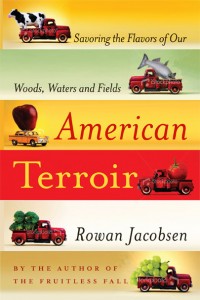 When I first read about American Terroir: Savoring the Flavors of Our Woods, Waters, and Forests by Rowan Jacobsen, I thought it was going to be a catalog of what areas are known for what foods. I was pleasantly surprised to discover that this book goes much deeper than that, calling us to develop a relationship to the foods around us.
When I first read about American Terroir: Savoring the Flavors of Our Woods, Waters, and Forests by Rowan Jacobsen, I thought it was going to be a catalog of what areas are known for what foods. I was pleasantly surprised to discover that this book goes much deeper than that, calling us to develop a relationship to the foods around us.
Granted, I was disappointed to flip to the index to look for Michigan only to discover that there is no index. Then I started reading. I learned much more about how food is grown, processed, and affected by its environment that I even realized. The other day I started a conversation with my co-workers about potatoes, for goodness’ sakes.
At first I was a bit confused by the chapter titles. “The Fresh Young Thing,” “Little Truths,” “That Totten Smell”–what kind of foodie book was this? Then I realized that the author is calling us to think about foods and where they come from, to respect them, to become friends with them. Each has their own personality. Then the chapter titles began to make sense:
- In the Church of the North Woods: High-Mountain Maple Syrup, Vermont
- The Fresh Young Thing: Geisha Coffee, Panama
- Eat Me: New England Cider and Yakima Valley Apples
- Mother Nature’s Little Black Book: Varietal Honeys of New England, North Carolina, Florida, the Southwest, and California
- Spud Island: Moules Frites on Prince Edward Island
- Little Truths: Forest Gastronomy, Quebec
- That Totten Smell: Totten Inlet Oysters, Puget Sound
- Fat of the Land: Slow-Ripened Avocados, Michoacan, Mexico
- The Taste of Vigor: Yukon River Salmon
- The Farm Girl and the Pole Dancer: Wines without Makeup, California
- The Whisper in Darkness: Washed-Rind Cheese, Northeast Kingdom, Vermont
- The Blood of the Gods: Misoamerican Chocolate, Chiapas, Mexico
Each chapter begins with a bit of science that explains how the item is affected by its terroir, or environment. Then he travels to where excellent specimens are produced. Each chapter includes a couple of recipes that feature the ingredient, plus a list of resources (although I found myself inspired to seek out local examples).
My favorite quote about the book came from Jerome Copulsky, The New Republic: “One cannot help but get a little hungry while perusing Jacobsen’s enchanting book. Part manifesto, part travelogue, part science lesson, and part cookbook, this saliva-inducing work is perhaps best described as erotica—a sensual, titillating, sometimes lewd journey into the best foodstuffs of America. . . . a vitalist—one might even say pantheist—sensibility courses through these pages.”
After reading this book, I was inspired to start learning even more about the unique terroir of West Michigan, to develop a relationship with my environment to see why local foods taste the way they do. This was reinforced in my foraging class last week, and also in my gardening experiments. It opened my eyes to local flavor.
Disclosure: I received a complimentary review copy from the publisher. All opinions are my own.



Very interesting!! Local ingredients are certainly the way to go! Miriam@Meatless Meals For Meat Eaters
I like that it’s part travelogue, science, and cookbook. Local, organic is the way to go, just as it has been for millions of years.